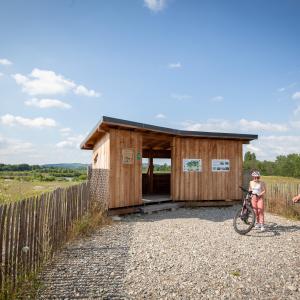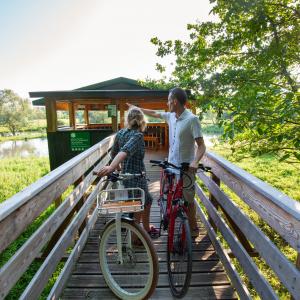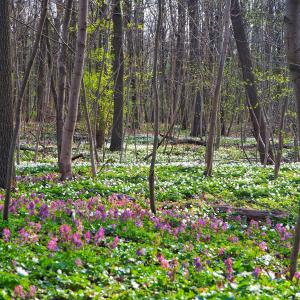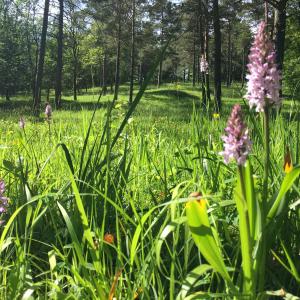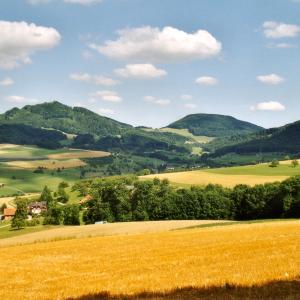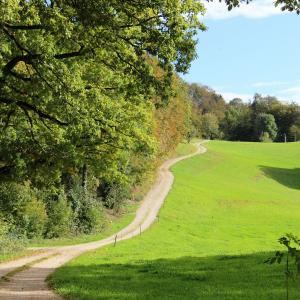At the Heart of Great Natural Spaces
The Three Counties Region is characterised by the importance of nature. The Rhine is a central natural feature, but there are also parks and forest areas, as well as nature reserves, which are home to remarkable plants and animals. Enjoy the peace in these spaces and see what’s unique about them.
Hardt Forest
The Hardt Forest is a wooded strip that stretches between the Ill River to the east of Mulhouse and the Rhine river, near the Franco-German border. It borders the towns of Roggenhouse to the north and Bartenheim to the south. Orientated from north to south, this 45 km long, green forest is still relatively unspoilt and is a delight for cyclists, who can cross it on a straight forest track with moderate elevation changes. It is also possible to cross it by following the Rhône-Rhine canal in an east-west direction from Mulhouse to the Grand Canal d'Alsace and the Huningue Canal. Its unspoilt natural setting is ideal for strolling and its many green spaces are home to a wide variety of water birds.
The Hardt forest once stretched for 60 kilometres from Basel to Neuf-Brisach. It was originally the hunting ground of Mulhouse and Neuf-Brisach’s wealthy classes, which can still be seen in the place names and the numerous hunting huts. In addition, a number of blockhouses from the Second World War and various information signs explain Franco-German history. The Hardt was classified as a Special Protection Area in 2005 as part of the European Natura 2000 project.
Petite Camargue Alsacienne
The Petite Camargue Alsacienne nature reserve is located in the French commune of Saint-Louis near the French-German-Swiss border. This 900-hectare area is a remarkable mosaic of environments: wet meadows, mown meadows, reedbeds, alluvial forests and arable land used for intensive agriculture. There was therefore good reason for the French government to declare it as the first natural area in Alsace in 1982. The plants and animals are very varied: 40 species of dragonflies, about 200 species of birds, a dozen species of fish and over 70 types of flowers. Scottish Highland cattle also live on the marshy areas of the reserve, helping to maintain it. The Petite Camargue Alsacienne is open to the public all year round and easily accessible by public transport, bicycle, by foot or in a car. This extraordinary space can be discovered on foot by following the signposted paths. Along the route, there are numerous observatories to admire the beauty of the surrounding nature. In addition, two permanent exhibitions on fish farming and the history of the Rhine are located in the two Lockmaster's House buildings in the heart of the reserve.
Want to know more about the nature reserve, the hiking trails and the permanent exhibitions? Consult the website: www.petitecamarguealsacienne.com
Wiese Landscape Park
This largely undeveloped plain of just under 6 square kilometres lies at the heart of the Basel trinational conurbation. Bordered by the Wiese River, the park is a popular place to relax for residents of the neighbouring areas of Weil am Rhein, Lörrach, Basel and Riehen. It is a real natural setting in the heart of the city. In addition, it is the largest natural water reserve for the drinking water supply of the southern Markgräflerland and the city of Basel. The Wiese Landscape Park comprises landscape protection areas, small and large, of local, regional and national importance. The Nonnenholz and the Langen Erlen Wildlife Park are the largest wooded areas adjacent to the park. It’s an essential habitat for people, animals and plants. Due to the lowering of the water table as a result of the Wiese’s canalisation, the alluvial forest has become a deciduous forest with corydalis, hornbeam and other unique deciduous trees in Switzerland. Water, in all its forms, still marks the cultural landscape of the Wiese Park. Large areas of subterranean water protection, landscape protection areas and natural reserves have been set out there.
Find more information at: https://www.landschaftsparkwiese.info
Aargau Jura Park
The Aargau Jura Park is a 245-square-kilometre nature park in the north-western part of the Swiss canton of Aargau, between Basel and Zurich. In 2012, it was recognised as a "Regional Nature Park of National Importance" by the Swiss Federal Office for the Environment because of its rich natural habitat and beautiful landscape. With its 28 communes (27 in Aargau and one in the canton of Solothurn), this landscape park between the Rhine and the Aare delights its inhabitants and visitors with its unspoilt nature and idyllic setting. Here you can admire the Jura mountain range and plateau, or contemplate the beauty of the Frick Valley when its cherry trees are in bloom. Higher up, the Wasserflue offers an incredible view. The vine-covered slopes of the Schenkenberg Valley are also ideal for relaxation, not to mention the bright pine forests which are home to several types of local orchids. In addition, there is a large number of local producers of delicious products, with almost three hundred of them having already received a certification. This is a truly gourmet offer that the park's inhabitants and visitors can enjoy by buying directly at farms and market stalls. The regional development project “La route du goût” or “The Taste Route” links the region's producers along a 180-kilometre route, and many other projects for the preservation and enhancement of the region's cultural and natural assets are being carried out by local people working towards the sustainable development of the regional nature park. Numerous events and other exciting excursions bring the region to life throughout the year.
Want to know more about the Aargau Jura Park? Consult the website: https://jurapark-aargau.ch/home.html
Wildenstein Nature Reserve (Baselland Canton)
The Wildenstein nature reserve is located at an altitude of around 500 metres, on one of the high plateaus of Tabular Jura above Bubendorf. The unique thing about this nature reserve, covering a little more than one square kilometre, is its old oak forest, which is over 500 years old. These centuries-old trees have seen a cultural landscape with a lot of tradition. For wood-boring beetles and many species of lichens, this area is considered one of the most important in Central Europe. This is why the Swiss Confederation classed it as a nature reserve of national importance. The area surrounding the “Schlossgut” was acquired by the canton in 1994, then classed as a natural reserve.
More information at http://www.naturschutzdienst-bl.ch

